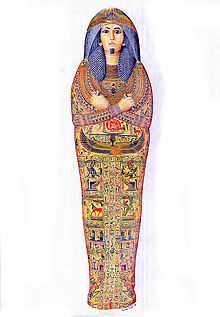Nesyamun
Coordinates: 53°48′04″N 1°32′53″W / 53.801°N 1.548°W

Nesyamun otherwise known as The Leeds Mummy, and his coffins are amongst the best researched of their kind. Nesyamun was a priest, incense-bearer and scribe at the ancient Egyptian temple complex at Karnak and died over 3,000 years ago, around 1100 BC. His body was then preserved and entombed ready for the after-life. Ever since he arrived at the Leeds City Museum in 1823, he has been recognized as one of the most remarkable mummies in Britain.
In 1990 the Director of Leeds City Museum invited Dr. Rosalie David, (now Professor), to undertake a new scientific study of the mummy of Nesyamun. this multi-disciplinary team was set up in 1973 to discover more about the living conditions, diseases, and causes of death of the ancient Egyptian population, and also to establish formal non-destructive methods of examining mummified remains. The International Mummy Database founded at the Manchester Museum in 1979 is now recognized as the major center for the collection and storage of mummy-related information from all over the world.
Since 2002, Leeds Museum have been documenting and researching both the decoration upon the coffin, and the coffin itself. This has led to a greater understanding of the nature of the roles that Nesyamun, as a priest at the temple of Karnak, would have adopted.
On September 4 2008, the mummy was moved to a new home at Leeds City Museum. [1]
References
- Wassell, Belinda The Coffin of Nesyamun: the "Leeds Mummy" The Leeds Philosophical and Literary Society, 2008. Illustrations by Thomas Small. ISBN 1-870737-21-0